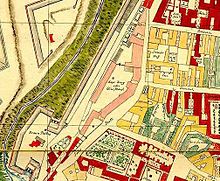Imperial Armory (Lower Arsenal)
The Imperial Armory , also known as the “Lower Arsenal”, “Imperial Lower Armory and Casting House” or “Old Armory”, was used, among other things, to cast large artillery pieces. It was topographically “below”, near the Wien River , in contrast to the bourgeois armory at the court .
history
The armory was located in the 1st district of Vienna at Seilerstätte , today between orientation numbers 7 and 13 between Weihburggasse and the now extended Johannesgasse, directly on the city wall , where Schellinggasse runs today (O-No. 2 - 8th). In 1771 the building was given the conscription number 984 and in 1821 the number 958. The Ronacher is located in one of the two current blocks of houses . During its renovation in 2006 and 2007, remains of the cellar vault of the armory were found.
In 1677 the armory was rebuilt under the President of the Court War Council, Count Raimondo Montecuccoli . In 1696, Prince Mansfeld had the arsenal expanded to include the chapel “To the Holy 3 Kings”. From 1714 to 1723 the Imperial Armory was rebuilt according to plans by the imperial fortification master builder Donato Felice d'Allio . Feldzeugmeister Joseph Colloredo-Mels and Wallsee had the building expanded in 1805.
In contrast to the " upper arsenal " in Renngasse, the "lower" armory did not serve as a depot , but was used as a workshop for repair work and as a production facility for weapons, mainly large guns. Later the building served as a barracks . In 1869 the building was demolished and Himmelpfortgasse was extended towards the Wienfluss. The apartment buildings at Seilerstätte 7, 9 and 11, Weihburggasse 26 and Himmelpfortgasse 20 were built on its site.
See also
- Imperial Armory (Upper Arsenal) , Renngasse
literature
- Friedrich von Leber: Vienna's Imperial Armory: For the first time viewed from a historical-critical point of view [...] . Leipzig 1846 (part 1: digitized version )
- Felix Czeike : Historical Lexicon Vienna. Volume 1: A – Da. Kremayr & Scheriau, Vienna 1992, ISBN 3-218-00543-4 .
Individual evidence
- ↑ Museums der Stadt Wien - Stadtarchäologie: Findort Wien 11, 2008. Research from the field of Stadtarchäologie Wien (PDF; 83 kB), Forum Archaeologiae 49 / XII / 2008
Coordinates: 48 ° 12 ′ 17 ″ N , 16 ° 22 ′ 26 ″ E
